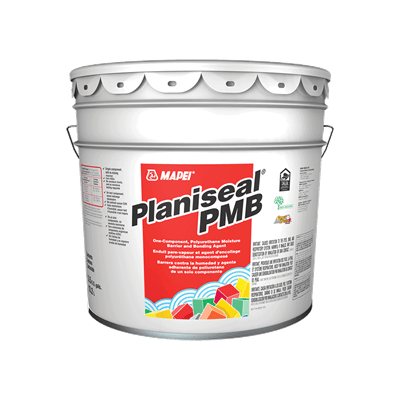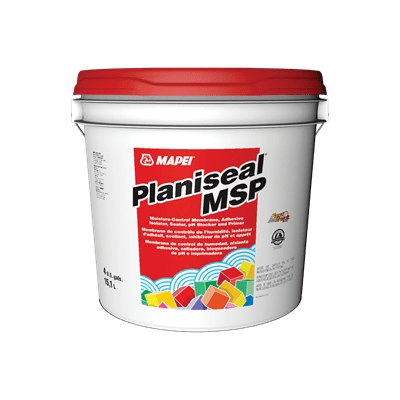Waterproofing is just that, it stops liquid water from moving from one space to another; it does not stop water in a vapor form completely (though it can slow it down). Waterproofing and moisture barriers are completely different products with different jobs. You would use a waterproofing membrane to contain water in a certain area, like a shower pan for example.
Moisture-reduction barriers control moisture in a vapor state. These membranes fill the pores of the substrate, typically with epoxy or a polymer, and keep virtually all vapors from passing through within the specific products limits. These types of products are well-suited for treating high-moisture slabs, or where a concern of high moisture conditions in the future exists.
What are the differences in composition of the products?Waterproofing membranes are typically a liquid-rubber type material that is applied similar to traditional wall paint. Mapelastic AquaDefense for example, is rolled onto the substrate with a 3/8” nap paint roller in two coats. There are other types that require reinforcing fabrics and meshes or application with a trowel vs. a roller; though roller-applied membranes are most common. There are also cement-based waterproofing membranes like our Mapelastic 315, which is a cement powder that is mixed with a supremely flexible additive, and is then trowel-applied in conjunction with a reinforcing fiberglass mesh for added strength.
Moisture-Reduction Membranes can vary in composition quite a bit, but the three most popular types MAPEI manufactures are epoxy, polyurethane, and polymer-based. First, epoxy (the most popular choice) does a phenomenal job of filling open concrete pores and making a monolithic membrane to guard against vapor transmission. Epoxies can be a touch difficult to work with, and most of these types of membranes will have moisture vapor emission limits. This brings us to products like our Planiseal PMB, which is polyurethane. Polyurethanes like Planiseal PMB can be applied easily using a paint roller, and are already pre-mixed saving time and frustration. Some of these products have moisture limits, but Planiseal PMB does not (so long as the slab has no standing water on it). Finally, polymer-based moisture-reduction membranes like our Planiseal MSP are inexpensive, easy to apply, and are typically very available in the marketplace. These products fill a great niche, but do not have incredibly high moisture limits.
So, how do you choose? Decide if you need to stop “water” or “Water Vapor”. If you need to stop water from moving to one area to another, like creating a basin to keep water in a fountain, you need a waterproofing membrane. If you are dealing with a high moisture concrete slab, and need to install solid sheet vinyl, then a moisture-reduction barrier would be the ideal choice.





Toll-free within Canada:
Technical Services at 1-800-361-9309
Customer Service at 1-800-668-1212
Copyright © 2025 MAPEI Inc. All rights reserved.
2900, avenue Francis-Hughes, Laval (Québec) H7L 3J5
Comments
Load more comments